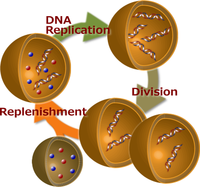ELSIセミナー
Constructive Approach towards Vesicle-based Protocell
- スピーカー
- Tadashi Sugawara (Professor, Kanagawa University)
- 日付
- October 22, 2014
- 場所
ELSI Building - 104 Communication Room
Construction of a protocell from a material side is a promising approach to reveal the missing link between life and material worlds. We pursued this goal in terms of a synthetic approach by assembling not only prebiotic molecules but also well-designed ad hoc molecules, expecting that they demonstrate collaborative dynamics similar to those of a living cell. As for self-reproduction of GV, for example, GVs constructed by cationic membrane molecule (V), membrane lipid precursor (V*), amphiphilic catalyst (C) exhibited self-reproductive dynamics, such as birthing [1] or budding and division [2]. As a GV-based model protocell, it is indispensable to replicate RNA/DNA in GV to deliver the information to the descendant. Self-replication of DNA in GV was performed by thermal cycles using a template DNA of 1229 bp and a polymerase (Shohda, et al.) [3]. The linkage between the self-replication of DNA and the self-reproduction of GV was achieved by virtue of a "DNA-complex" with cationic lipids, including the amphiphilic catalyst C [4]. It is to note that the DNA-complex, which was formed spontaneously within the vesicular membrane, served as a "pseudo-enzyme" to convert the precursor V*to the membrane lipid V and also as a scaffold for the GV-division. Acquisition of recursive ability of the self-proliferative GV was achieved by replenishment of depleted nucleotides to daughter GVs through the "vesicular transport system"[5], which makes repeated proliferation of the vesicle-based protocell possible.
An ultimate protocell that can autonomously evolve would develop if a "mutant" appeared during proliferation cycles, Fig: Cell cycle of GV-based protocell
associated with the correlation between geno-type and pheno-type established in the GV-based protocell.
References
[1] K. Takakura K, et al., J. Am. Chem. Soc. 125, 8134-8140 (2003), [2] K. Takakura, et. al., Langmuir 20, 3832-3034, (2004), [3] K. Shohda, et al., Soft Matter, 7, 3750-3753 (2011), [4] K. Kurihara, et al., Nature Chem. 3: 775-781, [5] K. Suzuki, K. et al, Chem. Lett., 41, 789-791 (2012).













